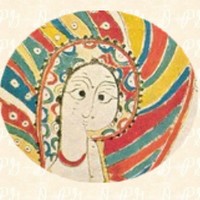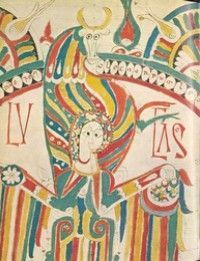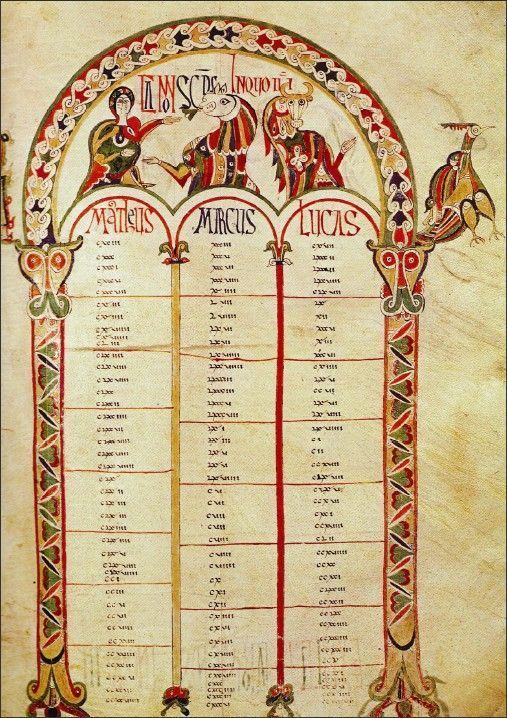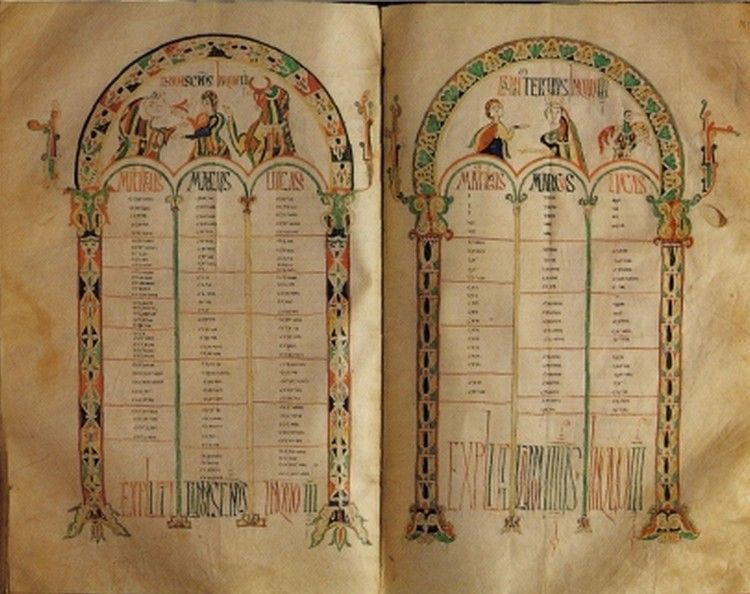BIBLIA SACRA DE LEÓN

Notas Previas
- Reference: Museo de la Catedral de León. Códice nº 6.
- Other names: Biblia de Vimara, Biblia de Juan y Vimara.
- Dimensions: 240 x 365mm.
- 275 folios of Visigoth small-case parchment in two 38-line columns in his first two notebooks and 53 in the remaining.
Entorno histórico
Descripción
 diocese. In its pages were added multiple comments to the work of Juan and Vimara, some generated by the authors themselves, many of them in Arabic.
diocese. In its pages were added multiple comments to the work of Juan and Vimara, some generated by the authors themselves, many of them in Arabic.
Considered one of the most important works of our early medieval iconography, the Sacred Bible of the Cathedral of León painted by Deacon John in the year 920 responds to a style unrelated to that of the Blessed, typical of an artist not subjected to any school. It offers an amazing set of miniatures in which, although you can find multiple backgrounds and stylistic influences, the personality and originality of its illuminator make them something special, perfectly differentiated from the rest of the codices of the same time.
Indeed, his drawings impress by their great capacity for synthesis and by their freedom of expression, both graphic and chromatic, constituting a perfectly differentiated set. In it we find both initial letters decorated with figures  human beings such as those that appear for the first time in Merovingian manuscripts, from where they went to the Mozarabic ornamental repertoire in which it has already been used since the beginning of the 10th century, for example, in the Vitae Patrum of Armentarius, as drawings to be repeated later in many other codices, such as the Cross of Oviedo, the wind rose, New Testament scenes, Umayyad palm trees or symbols of the Evangelists.
human beings such as those that appear for the first time in Merovingian manuscripts, from where they went to the Mozarabic ornamental repertoire in which it has already been used since the beginning of the 10th century, for example, in the Vitae Patrum of Armentarius, as drawings to be repeated later in many other codices, such as the Cross of Oviedo, the wind rose, New Testament scenes, Umayyad palm trees or symbols of the Evangelists.
With an extraordinary artistic sense, he often uses colors of raw tones, always on uncoloured backgrounds, occupying entire pages or in vignettes or circles inserted in pages containing text. It also includes decorative arches enclosed within another large arch, in the style of San Fructuoso de Montelios, separating the different columns from the text, in which it avoids monotony by using different motifs and shapes in the columns, their bases and their capitals – which in some cases recall those of Visigoth churches such as San Pedro de la Nave or Obiols and the carvings of some pilasters of Mérida -, as well as in the figures of the head of the arches, which are of half a point in most cases, unusual in the Mozarabic miniature.
However, both because of the maturity and security that Juan demonstrates in his compositions and because of his multiple coincidences with other Hispanic manuscripts of the same period, it is evident that this creation belongs to a long tradition of miniature in the peninsula that, started possibly in the great scriptorium visigoths of the seventh century, remained in some Christian monasteries of Asturias and Navarre and grew up among the Christians of Andalusia, who were also able to broaden their knowledge in an environment as positive for culture as the Caliphate of Cordoba. Only the existence of previous models of a well-defined style and content would explain the similarities appreciated in the miniatures of some codices made in the first half of the tenth century, some being geographically distant, and even made in territories under Muslim domination.
the similarities appreciated in the miniatures of some codices made in the first half of the tenth century, some being geographically distant, and even made in territories under Muslim domination.
Within the set of miniatures of the Sacred Bible, of such high quality and originality, which are characterized by the honeycombed structure of the forms, as well as their distribution in colors segmented by the lines, as if they were different cells of a jewel, of great decorative effect and expressive vigour, it is obligatory to highlight its pages of the evangelists, in which for the first time the traditional Carolingian representation of the four medallions of the evangelists flanking a Christ in central Majesty is replaced, which here are represented in full page by magnificent winged angels within the medallion, with the animal of the tetramorphs on its upper edge, and the intersection of four rosettes of  smaller size and rich Sassanid decoration.
smaller size and rich Sassanid decoration.
the one hand the bull and the head of Saint Luke of this Bible and on the other the bull of Guernica and the head of one of the Demoiselles d’Avignon. We know that in 1924, at the height of Cubism, the Society of Friends of the Art organized in Madrid an exhibition of Spanish manuscripts after a forgetfulness of many centuries this facet of our art that already advanced a great part of the techniques used at the beginning of the 20th century. However, although the Guernica is much later than that date, Picasso painted the Signesses of Avignon many years earlier, in 1907. It would be very interesting to know if before that date had already had the opportunity to know the Sacred Bible of Leon, to be able to establish the relationship that has been possible between the Mozarabic miniature of the tenth century and the artistic avant-gardes of the twentieth.
Bibliografía
Historia de España de Menéndez Pidal: Tomos VI y VII*
SUMMA ARTIS: Tomos VIII y XXII
L’Art Préroman Hispanique: ZODIAQUE
Arte y Arquitectura española 500/1250: Joaquín Yarza
Portales
Manuscritos miniados mozárabes/
Catálogo de códices de la Catedral de León, pág. 5.
El monasterio de Abellar ó de los santos mártires Cosme y
Damián








